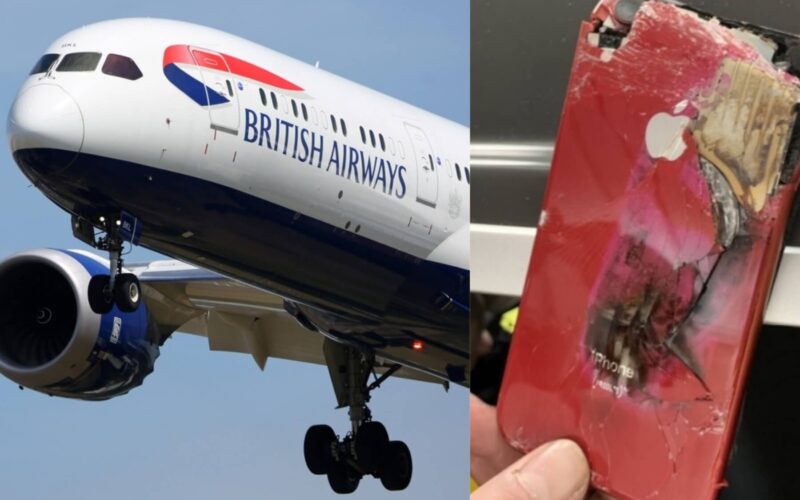The UK’s Air Accidents Investigation Branch (AAIB) published an investigation report on the incident of a fire onboard the British Airways Boeing 787-9 aircraft caused by a crushed iPhone.
What happened on board British Airways Dreamliner?
On October 1, 2020, British Airways Boeing 787-9, registered as G-ZBKF, was en route from Miami International Airport (MIA), United States, to London Heathrow Airport (LHR), the UK.
About 40 minutes before landing at LHR airport, when the jet was descending, the flight crew made an announcement, which woke up one of the passengers. The passenger moved her seat to an upright position and went to the washroom.
While the passenger was away from her seat, a flight attendant came to remove the bedding and noticed a strong odour. It was coming from a charging cable plugged into the seat socket with its other end hanging on the side of the seat. The smell was getting stronger. A few moments later, the cabin crew heard an unusual sound and noticed a gray smoke emanating from the seat. They also saw an orange glow in the seating area.
The investigation disclosed that the cabin crew member who was the closest to the scene took the first fire extinguisher and fire gloves for the senior cabin crew member (SCMM) and asked a third cabin crew member to switch the seat power off. The SCMM pulled back the seat padding, noticed a phone trapped in the seat mechanism, and discharged several bursts of the fire extinguisher into the device. The flight attendant then took a water extinguisher and filled the ice bucket with water.
Meanwhile, the third cabin crew member was communicating with the flight crew informing them that thick smoke was emanating from a seat in the forward part of the cabin and the crew used a firefighting drill. However, shortly before receiving the call from the flight attendant, pilots had already smelt an odour in the flight deck.
The pilots immediately started the smoke, fire, or fumes checklist and evaluated their diversion options. Meanwhile, the third pilot of the jet went back to the cabin to assist.
When the SCCM discharged the fire extinguisher, the smoke vanished and the cabin crew noticed a red mobile phone trapped in the seat mechanism, which they attempted to remove. However, the device was jammed. Since some heat was still coming from the phone, the cabin crew decided to check for secondary heat sources but did not find any of them and reported to the Captain about the ongoing situation. One of the flight attendants remained seated near the place of the incident being equipped with an extinguisher and ready to discharge it if needed.
The conclusion of the investigation
According to the report, since the source of the grey smoke had been identified and the fire was extinguished, the Boeing 787-9 was only 20 minutes from landing at the planned destination and the Captain of the airline decided to continue flying to the LHR airport. The flight crew also alerted Air Traffic control about the emergency onboard to ensure the fire services met the jet on landing. The Captain also made an announcement to the passengers as well as gave a NITS briefing for the cabin crew members.
Fortunately, the aircraft landed safely at Heathrow with no further incidents and no damage to the aircraft.
The investigation found that the passenger’s phone was trapped in the seat mechanism and was damaged at the moment when the seat was adjusted before the passenger left for the washroom. This action damaged the battery of the phone while generating smoke, flames, and fumes.
The AAIB also concluded that the airline had the appropriate announcement for passengers on all its flights onboard jets equipped with electrically powered seats to prevent electronic devices to be lost, as is recommended by the European Union Aviation Safety Agency (EASA). The British authority also found out that the airline tried to redesign the seats in order to limit the risk of the electronic device being lost or trapped in the seat mechanism. However, such incidents continue to occur.
The operator’s investigation considered if the incident was managed appropriately by the crew and identified some aspects for further review. In particular, the SCMM was directly involved in the fire fighting process instead of allowing the crew member who first find out about the emergency situation to put out the fire. Due to fear to damage the seat electrics, the cabin crew also did not dowse the phone with water.
Following the investigation, the AAIB made this safety recommendation: “It is recommended that the Civil Aviation Authority require that passenger seats in commercial air transport aircraft are designed to minimize the chance of portable electronic devices becoming crushed in mechanisms.”

